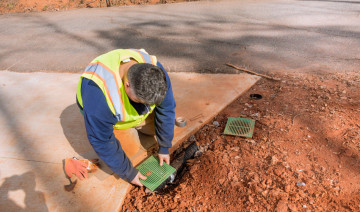- Location information 8 Convenient Locations

Solving Concrete Drainage and Runoff Issues
Share "Solving Concrete Drainage and Runoff Issues"
- Share this:
- Share on Facebook
- Pin on Pinterest
- Tweet on Twitter
Proper drainage is critical in any construction project, especially when working with concrete surfaces. Whether you’re building a driveway, patio, or sidewalk, addressing drainage and runoff issues is key to maintaining the integrity of the structure and preventing long-term damage. In this blog, we'll discuss the common causes of drainage issues in concrete surfaces and provide practical solutions to keep your projects durable and safe.
Why Addressing Concrete Drainage Matters
Concrete is a highly durable material, but it is not impermeable. Without proper drainage, water can pool on the surface or infiltrate cracks, leading to serious issues such as:
- Erosion: Runoff can erode the surrounding soil, destabilizing the foundation and leading to costly repairs.
- Cracking and Deterioration: Water that seeps into cracks and joints can freeze and expand in colder weather, causing cracks and weakening the concrete.
- Mold and Mildew: Standing water promotes mold and mildew growth, which can damage concrete over time and create slippery surfaces.
- Foundation Issues: Poor drainage can lead to water pooling around the foundation of a home, potentially causing foundational shifts, cracks, and even flooding.
Common Causes of Concrete Drainage Issues
- Improper Slope: If a concrete surface is not properly sloped, water will not drain off the surface efficiently and may pool in certain areas.
- Blocked or Insufficient Drains: A lack of proper drainage systems or clogged drains can cause water to collect, leading to runoff issues.
- Cracks or Gaps in the Concrete: Over time, even small cracks can allow water to seep in, leading to larger drainage problems.
- Surrounding Landscape: Poor landscaping choices can divert water toward the concrete surface rather than away from it, increasing the likelihood of runoff and erosion.
Practical Solutions for Concrete Drainage and Runoff
1. Ensure Proper Slope
A well-constructed concrete surface should have a slight slope to allow water to flow away from the surface. The recommended slope is typically 1/8 to 1/4 inch per foot, depending on the size of the area. If the surface was not originally installed with the proper slope, you may need to:
- Resurface or Repour: In some cases, a complete repour with the correct slope may be necessary.
- Add a Topping Layer: For minor slope issues, a thin topping layer of concrete or a leveling compound may be enough to redirect water.
2. Install Drainage Systems
Drains are a key solution to controlling water runoff, especially for large areas like driveways, patios, and walkways. Options include:
- French Drains: These drains collect and direct water away from the concrete surface via a perforated pipe system buried underground.
- Trench Drains: Commonly used in driveways and parking lots, trench drains are installed at the edge of concrete surfaces to collect and channel water to an appropriate outlet.
- Catch Basins: A catch basin is a large container installed underground that collects excess water and slowly releases it into a drainage system.
Ensure that these drains are regularly maintained to prevent clogs, which could lead to standing water and runoff problems.
3. Seal Cracks and Joints
Small cracks and gaps can lead to significant water infiltration, particularly during freeze-thaw cycles. Regularly inspect your concrete surfaces for cracks and seal them with a high-quality concrete sealant. For larger cracks, you may need to:
- Use a Concrete Patch: For cracks larger than 1/8 inch, use a patching compound to fill the gap before sealing.
- Install Expansion Joints: In some cases, expansion joints may need to be added to accommodate movement and prevent further cracking.
4. Add Permeable Pavers or Gravel Surrounding the Concrete
If water tends to pool around the edges of a concrete surface, adding permeable materials like gravel or pavers can help manage runoff. These materials allow water to seep into the ground rather than collect at the surface.
- Permeable Pavers: These pavers have gaps between them that allow water to drain into the ground below, reducing runoff and preventing erosion.
- Gravel Border: A gravel border around the concrete surface can also help direct water away, while enhancing the aesthetics of the area.
5. Improve Landscaping and Grading
The area surrounding a concrete surface plays a critical role in drainage. Ensure the landscaping directs water away from the concrete and foundation:
- Grade the Soil: The soil should slope away from the concrete, typically at a 5% grade for the first 10 feet away from the structure.
- Choose Water-Friendly Plants: Planting drought-resistant or water-loving plants around your concrete areas can help absorb excess moisture and reduce runoff.
6. Apply Waterproof Sealants
Applying a waterproof sealant to concrete surfaces can help protect against water penetration. Sealants create a barrier that prevents moisture from seeping into cracks and pores in the concrete, extending the life of the structure.
Preventing Future Runoff Problems
Once the drainage issues have been addressed, it’s important to establish a maintenance plan to prevent future problems:
- Inspect Regularly: Check concrete surfaces for cracks, erosion, and standing water at least once a year.
- Clean Drains and Gutters: Ensure that drains, gutters, and downspouts are free of debris to prevent clogging.
- Reseal Concrete: Depending on wear and tear, reseal concrete surfaces every few years to maintain their protective barrier.
Conclusion
Solving concrete drainage and runoff issues requires a mix of proactive planning, regular maintenance, and, when necessary, corrective measures. By ensuring proper slope, installing drainage systems, sealing cracks, and improving surrounding landscaping, contractors and DIY homeowners can prevent water damage and maintain the durability of their concrete surfaces for years to come. With these practical solutions, you can protect your projects and ensure they withstand the elements.
